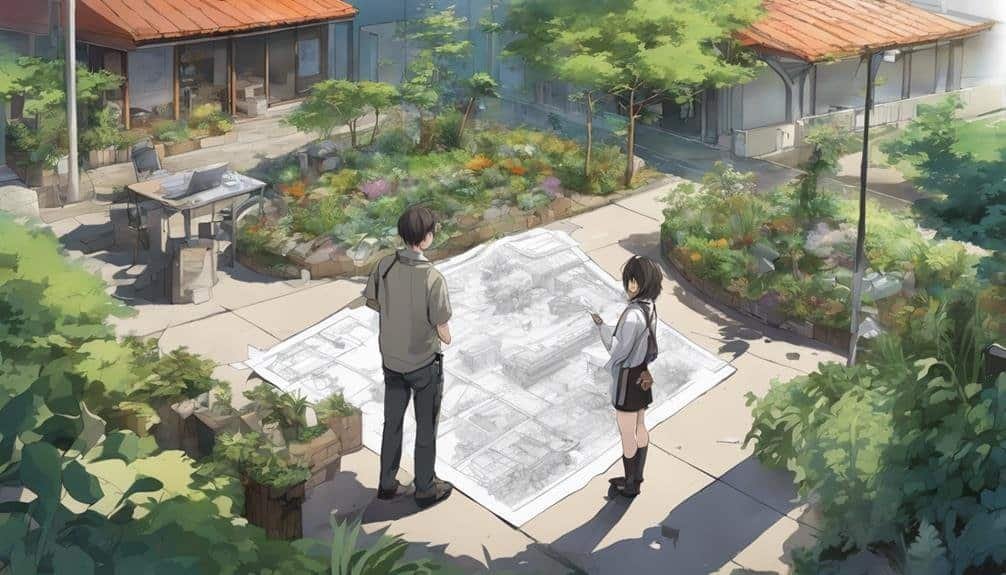Job Duties for Landscape Architect
In the landscape architecture, the role of a professional extends beyond simply envisioning aesthetically pleasing outdoor spaces. The multifaceted responsibilities of a landscape architect encompass a diverse array of tasks that go beyond the surface level.
From analyzing the intricacies of a site to collaborating with various stakeholders, the job duties explore into a domain that demands both creativity and practicality. The blend of artistry and technical expertise required in this profession results in a dynamic field that continuously evolves, offering challenges and opportunities for those in pursuit of creating impactful environments.
Key Takeaways
- Blend artistic vision, environment, and function for sustainable outdoor spaces.
- Conduct thorough site analysis to inform design decisions and promote ecological harmony.
- Collaborate with professionals for integrated solutions and client satisfaction.
- Manage construction implementation for on-time, on-budget project completion.
Designing Outdoor Spaces
Designing outdoor spaces as a landscape architect involves the intricate blend of artistic vision, environmental considerations, and functional requirements to create harmonious and sustainable environments. A pivotal aspect of this process is plant selection, where the landscape architect carefully chooses flora that suits the local climate, soil conditions, and aesthetic preferences of the client. This decision not only enhances the visual appeal of the space but also contributes to its ecological sustainability.
Moreover, project budgeting plays a significant role in the design phase. Landscape architects need to balance their creative ideas with the financial constraints of the project to make sure that the client's budget is respected without compromising the quality of the design. Sustainable practices are also integrated into the design process, such as utilizing native plants to reduce water consumption and implementing eco-friendly materials to minimize environmental impact.
Effective client communication is key throughout the design stage, as landscape architects must convey their ideas clearly and address any concerns to ensure client satisfaction with the final outdoor space design.
Conducting Site Analysis
Conducting site analysis as a landscape architect involves meticulously examining the natural features, topography, and environmental conditions of a designated area to inform the design process with a thorough understanding of the site's unique characteristics and potential challenges. This important step in the design process helps in creating sustainable and harmonious outdoor spaces that blend seamlessly with the environment.
Here are three key aspects landscape architects consider during site evaluation:
- Microclimates: Understanding the varying microclimates within the site is essential for selecting appropriate plant species and designing spaces that are comfortable year-round.
- Soil Composition: Analyzing soil composition helps in determining drainage patterns, soil stability, and nutrient levels, influencing plant selection and overall design feasibility.
- Ecological Footprint: Evaluating the environmental impact of the proposed design safeguards that the project minimizes harm to the ecosystem and promotes biodiversity, creating landscapes that are not only aesthetically pleasing but also environmentally responsible.
Collaborating With Other Professionals
In the domain of landscape architecture, effective collaboration with diverse professionals is paramount for achieving integrated and innovative design solutions that harmonize with the environment and meet the needs of clients and communities. Landscape architects must excel in client communication, making sure that the visions and requirements of the clients are understood and translated into the design process seamlessly. This involves active listening, clear articulation of ideas, and the ability to incorporate feedback constructively.
Additionally, project coordination with various experts such as architects, engineers, and environmental consultants is important for a holistic approach to landscape design. Collaboration on sustainability practices is critical in today's environmentally conscious world. Landscape architects work closely with experts in sustainable design to implement eco-friendly solutions, from water management strategies to the selection of native plants that promote biodiversity.
In addition, the meticulous consideration of material selection is a collaborative effort that involves working with suppliers, contractors, and craftsmen to make sure that the chosen materials align with the design concept, budget constraints, and environmental sustainability goals. Successful collaboration with professionals from diverse fields enriches the creative process and leads to the realization of exceptional landscape projects.
Creating Project Proposals
The foundation of any successful landscape architecture project lies in the meticulous crafting of thorough and compelling project proposals that capture the essence of the envisioned design concept and cater to the specific needs and aspirations of the clients and communities involved. When creating project proposals, landscape architects must consider various elements to safeguard the viability and success of the project:
- Budget Considerations: Detailed analysis of the budget allocation is pivotal to guarantee that the proposed design aligns with financial constraints while delivering on aesthetic and functional requirements.
- Client Presentations: Engaging and informative presentations are essential to convey the proposed design concept effectively and solicit feedback from clients for further refinement.
- Environmental Impact, Material Selection: Evaluating the environmental implications of design choices and selecting sustainable materials are integral to minimizing the project's ecological footprint and promoting long-term environmental stewardship.
Managing Construction Implementation
Overseeing the seamless execution of construction activities is a critical responsibility for landscape architects during the implementation phase of a project. Construction oversight involves managing project scheduling to make certain tasks are completed on time and within budget. Landscape architects play a key role in quality control, making certain that the construction meets the design specifications and standards set forth in the project proposal. They conduct thorough site inspections to monitor progress, address any issues that may arise, and maintain the project's overall integrity.
During construction implementation, landscape architects work closely with contractors and subcontractors to coordinate labor, materials, and equipment efficiently. They are responsible for interpreting design plans, providing clarifications when needed, and making on-the-spot decisions to keep the project on track. Effective communication and problem-solving skills are essential in managing construction activities to overcome challenges and deliver successful outcomes. By actively engaging in construction oversight, landscape architects contribute to the realization of innovative and sustainable outdoor spaces that enhance the environment and enrich the community.
Conclusion
In the intricate tapestry of landscape architecture, the landscape architect weaves together elements of nature and human design to create harmonious outdoor spaces.
Through meticulous site analysis, collaboration with professionals, and skilled project management, they bring visions to life.
Like a master painter blending colors on a canvas, the landscape architect transforms empty land into vibrant works of art that inspire and uplift all who behold them.







